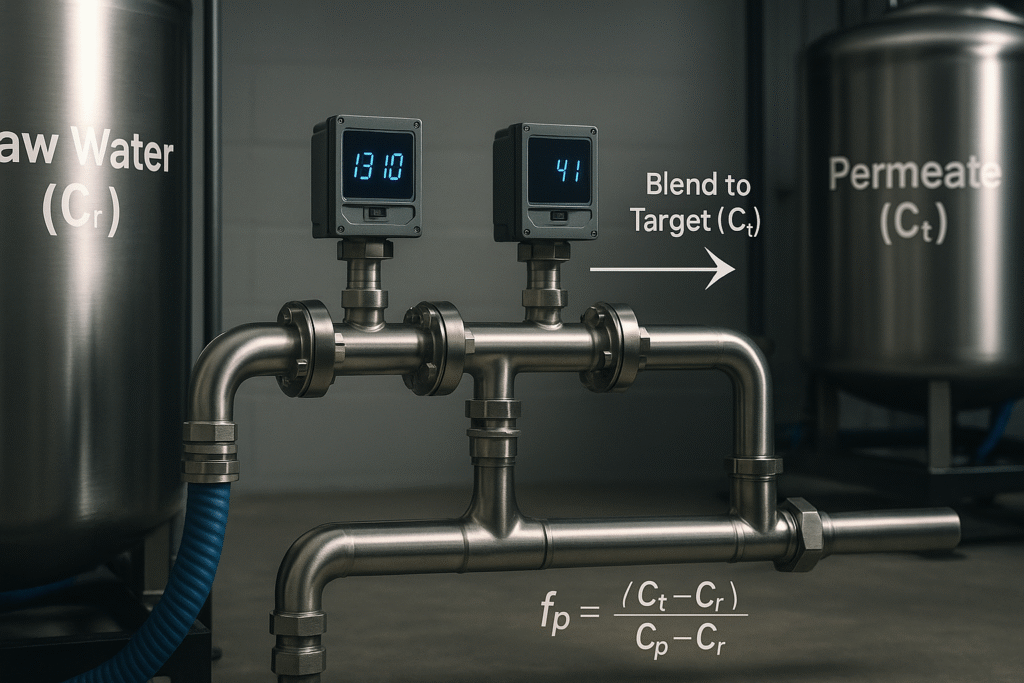Kalkulator Pencampuran Permeasi
What this permeate blending calculator does
Permeate blending calculator mixes raw water (conductivity/TDS = Cr) and RO permeate (Cp) to reach a target conductivity/TDS (Ct). It returns the required permeate fraction dan split flows (Qp, Qr) for a specified total blend flow. Results are shareable by URL and can be exported to CSV, so engineers and operators review the same assumptions and numbers.
When to use it
- Finished water must stay within a conductivity/TDS window (e.g., drinking, boiler feed, process rinsing).
- You want to blend back a small portion of raw water to reduce cost or adjust alkalinity/feel.
- During pilot/commissioning, you need fast estimates of ratios and flows at different set points.
Inputs explained
- Value unit: μS/cm (conductivity) or TDS (mg/L). Keep units consistent across inputs.
- Raw water (Cr): feed conductivity/TDS.
- Permeate (Cp): RO permeate conductivity/TDS.
- Target (Ct): desired conductivity/TDS of the blended stream.
- Total blend flow: target mixed flow; the tool outputs Qp and Qr.
Mass balance & formula
Assuming linear mixing at similar temperature and CO2 state:
Ct = fp·Cp + (1 − fp)·Cr ⇒ fp = (Ct − Cr) / (Cp − Cr).
Then Qp = fp·Qtotal and Qr = (1 − fp)·Qtotal.
Worked example
Cr=1500 μS/cm, Cp=60 μS/cm, Ct=200 μS/cm, Qtotal=1000 LPH.
fp = (200−1500)/(60−1500) = 1300/1440 ≈ 90.3%.
Qp ≈ 903 LPH, Qr ≈ 97 LPH.
Units & quick conversions
| Item | Rule of thumb | Catatan |
|---|---|---|
| Conductivity ↔ TDS | TDS ≈ Conductivity × 0.5–0.7 | Ion makeup dependent; verify on site. |
| LPH ↔ m³/h | 1000 LPH = 1 m³/h | Use consistent flow units in the tool. |
Good practice & caveats
- Sample and blend at similar temperature; large differences affect readings.
- Conductivity/TDS depends on ion makeup; if CO2 equilibrium or dosing reactions change, verify on site and keep a safety margin.
- Ini permeate blending calculator is an engineering estimate; finalize set points with online instruments and trend data.
Related reading
For scaling/corrosion tendency, see an overview of the Langelier Saturation Index (LSI). Use LSI alongside antiscalant design and temperature-corrected measurements.
From calculator to configured package
Need a configured reference? See the 1000 LPH RO Water Treatment Solution (architecture, KPIs and O&M guidance). You can also model operating cost with our RO OPEX Calculator.
What this permeate blending calculator does
Permeate blending calculator mixes raw water (conductivity/TDS = Cr) and RO permeate (Cp) to reach a target conductivity/TDS (Ct). It returns the required permeate fraction dan split flows (Qp, Qr) for a specified total blend flow. Results are shareable by URL and can be exported to CSV.
When to use it
- Finished water must stay within a conductivity/TDS window (e.g., drinking, boiler feed, process rinsing).
- You want to blend back a small portion of raw water to reduce cost or adjust alkalinity/feel.
- During pilot/commissioning, you need fast estimates of ratios and flows at different set points.
Inputs explained
- Value unit: μS/cm (conductivity) or TDS (mg/L). Keep units consistent across inputs.
- Raw water (Cr): feed conductivity/TDS.
- Permeate (Cp): RO permeate conductivity/TDS.
- Target (Ct): desired conductivity/TDS of the blended stream.
- Total blend flow: target mixed flow; the tool outputs Qp and Qr.
Mass balance & formula
Assuming linear mixing at similar temperature and CO2 state:
Ct = fp·Cp + (1 − fp)·Cr ⇒
fp = (Ct − Cr) / (Cp − Cr).
Then Qp = fp·Qtotal and Qr = (1 − fp)·Qtotal.
Worked example
Cr=1500 μS/cm, Cp=60 μS/cm, Ct=200 μS/cm, Qtotal=1000 LPH.
fp = (200−1500)/(60−1500) = 1300/1440 ≈ 90.3%.
Qp ≈ 903 LPH, Qr ≈ 97 LPH.
Good practice & caveats
- Sample and blend at similar temperature; large differences affect readings.
- Conductivity/TDS depends on ion makeup; if CO2 equilibrium or dosing reactions change, verify on site and keep a safety margin.
- This tool is an engineering estimate; finalize setpoints with online instruments and trend data.
Need a configured reference? See the 1000 LPH RO Water Treatment Solution (architecture, KPIs and O&M guidance).
PERTANYAAN YANG SERING DIAJUKAN
Apakah kalkulator pencampuran permeat mengasumsikan pencampuran linier?
Yes. It assumes linear mixing at similar temperature and CO₂ state. Verify on site if chemistry or temperature shifts are expected.
Dapatkah saya menggunakan TDS sebagai pengganti konduktivitas?
Ya. Gunakan satuan yang konsisten (TDS atau μS/cm) di seluruh input. Jika mengonversi, terapkan faktor situs Anda dan verifikasi dengan pengukur online.
Bagaimana jika hasilnya membutuhkan lebih banyak meresap daripada yang tersedia?
Kurangi nilai target atau tingkatkan ketersediaan permeat. Anda juga dapat memoles sebagian aliran mentah untuk menurunkan Cᵣ.
Seberapa akuratkah perkiraannya?
It is an engineering estimate for planning and commissioning. Final set points should be confirmed with online instruments and trend data.

